- Markets, finance and governance
- Financing (taxes, tariffs, transfers) and cost estimates
- Operating costs of dry sanitation (UDDTs) - and is 5% of household income a reasonable target?
Operating costs of dry sanitation (UDDTs) - and is 5% of household income a reasonable target?
22.2k views
To Hanns-Andre and others,
in the Andean region the typical material is adobe bricks.
The example between Uganda and Peru with the same material highlights as well the problems of generalized costs.
I think for the sake of comparability we should always consider a value for the maintenance. When the person does it on her own ...ok but this should not be considered as the regular case, as it might lead to failure of the system. And focusing on dense urban areas there is no way besides a service model.
Christoph
P.S. thanks for the flowers, the pictures cost me some trying to put them up
in the Andean region the typical material is adobe bricks.
The example between Uganda and Peru with the same material highlights as well the problems of generalized costs.
I think for the sake of comparability we should always consider a value for the maintenance. When the person does it on her own ...ok but this should not be considered as the regular case, as it might lead to failure of the system. And focusing on dense urban areas there is no way besides a service model.
Christoph
P.S. thanks for the flowers, the pictures cost me some trying to put them up
Please Log in to join the conversation.
You need to login to reply
Dear Christopher,
Thanks so much for this very detailed, picture supported post, which I have read with great interest. Of course, costs vary very much depending on the setting, and that ought to be documented. I think there are several points that I would like to make:
- Some more about the setting in Adjumani,
- Some more details about the assumptions in my calculation,
- Attitudes about human excrements.
You were talking about traditional construction in Peru, without giving details (it looks like stone). In Adjumani, bricks either burnt or unburnt, ARE the traditional way of construction. Many people first burn bricks in their own garden before they build a house. Of course, the quality is low, but the prices are also low. In addition, most people know how to build a pit latrine, and they tend to build it themselves. That is probably the main reason why that toilet is so popular in Adjumani (with more that 80% of all toilets being basic pit latrines).
In our low cost UDDT model, we used burnt bricks for better durability, and we used cement mortar in the understructure, mud mortar in the superstructure, and ferrocement for the covers. I also assumed that the whole toilet is built by trained craftspeople for better comparability. In addition to the construction of the toilet, there are, of course, also the expenses for the jerry cans for urine storage, possibly a toilet brush, a bucket for ash, or a hand washing basin, etc. (water is usually coming from a hand pumped borehole, more recently also from yard taps). All of that could add up to less than 200 Euro, or 260 dollars. Other costs are assumed negligible. If you do the calculation (at 5%, 10 years, 5 users), it should come out to less than 2 cents (US) per person per day.
Attitudes towards excrements vary widely, even within Uganda itself. In Adjumani, residents are assumed to empty their toilets themselves, and as I was mentioning, either the material is used on site, or it is picked up by the composting facility free of charge. I have even heard of at least one case where the owner of a toilet has sold the contents of his toilet to a farmer (almost everybody in Adjumani is a farmer in some way or another). So, it is dangerous to view things from the usually fecophobic perspective of the West. In Northern Uganda, people are usually not particularly fecophobic, even though not particularly fecophilic either, whereas in the South, they seem to be more on the fecophobic side. Whether this is because of a stronger western influence in the South, I don't know.
Overall, Adjumani probably had a rather conducive environment for ecosan promotion, and that certainly is one of the reasons for our relative success with ecosan promotion in that town. On the other hand, I think the setting was very much average at least for Northern Uganda, so that the cost figures are probably typical for small towns in the region. Larger towns would need a separate investigation. And then, ok, we need to clearly state the assumptions made in cost calculations.
Thanks again,
Hanns-Andre
Thanks so much for this very detailed, picture supported post, which I have read with great interest. Of course, costs vary very much depending on the setting, and that ought to be documented. I think there are several points that I would like to make:
- Some more about the setting in Adjumani,
- Some more details about the assumptions in my calculation,
- Attitudes about human excrements.
You were talking about traditional construction in Peru, without giving details (it looks like stone). In Adjumani, bricks either burnt or unburnt, ARE the traditional way of construction. Many people first burn bricks in their own garden before they build a house. Of course, the quality is low, but the prices are also low. In addition, most people know how to build a pit latrine, and they tend to build it themselves. That is probably the main reason why that toilet is so popular in Adjumani (with more that 80% of all toilets being basic pit latrines).
In our low cost UDDT model, we used burnt bricks for better durability, and we used cement mortar in the understructure, mud mortar in the superstructure, and ferrocement for the covers. I also assumed that the whole toilet is built by trained craftspeople for better comparability. In addition to the construction of the toilet, there are, of course, also the expenses for the jerry cans for urine storage, possibly a toilet brush, a bucket for ash, or a hand washing basin, etc. (water is usually coming from a hand pumped borehole, more recently also from yard taps). All of that could add up to less than 200 Euro, or 260 dollars. Other costs are assumed negligible. If you do the calculation (at 5%, 10 years, 5 users), it should come out to less than 2 cents (US) per person per day.
Attitudes towards excrements vary widely, even within Uganda itself. In Adjumani, residents are assumed to empty their toilets themselves, and as I was mentioning, either the material is used on site, or it is picked up by the composting facility free of charge. I have even heard of at least one case where the owner of a toilet has sold the contents of his toilet to a farmer (almost everybody in Adjumani is a farmer in some way or another). So, it is dangerous to view things from the usually fecophobic perspective of the West. In Northern Uganda, people are usually not particularly fecophobic, even though not particularly fecophilic either, whereas in the South, they seem to be more on the fecophobic side. Whether this is because of a stronger western influence in the South, I don't know.
Overall, Adjumani probably had a rather conducive environment for ecosan promotion, and that certainly is one of the reasons for our relative success with ecosan promotion in that town. On the other hand, I think the setting was very much average at least for Northern Uganda, so that the cost figures are probably typical for small towns in the region. Larger towns would need a separate investigation. And then, ok, we need to clearly state the assumptions made in cost calculations.
Thanks again,
Hanns-Andre
Hanns-Andre Pitot
M.Eng. Environmental Pollution Control
presently in Seesen, Germany
M.Eng. Environmental Pollution Control
presently in Seesen, Germany
Please Log in to join the conversation.
You need to login to reply
Dear Hans – Andre,
I like this discussion very much as we are discussing one of my main concerns when using numbers…the comparability. I would like to explain my point a bit (and I apologize to Jürgen when this post gets to long).
We did UDDT in the Cusco, Peru region using just local material, just an impression in these two pictures.
The only costs are piping (PVC) and the insert, the urinal and the toilet seat.
Total cost about U$ 100. No operational costs. (Case 1)
We could bring down these costs by substitution of the insert
By a funnel
So we are talking about U$ 50. (Case 2)
Now we come to the city…asentamiento of Lima but as well Amazon region smaller settlement close to a city.
The same layout but construction with bricks, the people are not able to do the brick work. The people to the superstructure as they choose to do. Costs of the double vault about, insert, urinal, piping about U$ 460 (case 3),
if a simple superstructure has to be added as the people are not able to do it on their own + U$ 230 (case 4).
And for a comparison I added the picture you posted (complete brick construction) and adapted it to our cost base in Peru, it would have the highest cost of all solutions, about U$ 860 (case 5).
The following table gives the base for the 5 cases.
When there is room to bury the dried feces and the people do it on their own all these examples stop here. But the typical point is that people do not like to handle their feces and the result might look like this.
Therefore I think we have to calculate a service model. A simple service would be to hire someone to clean out the chamber. I added this cost to all cases, my cost base has been 22 U$/toilet, year.
Up to this point we are comparing solutions for the exact same sanitation quality (the same technology UD double vault bench) for the user in 1 country!
Depending on the standpoint of view and method used the result ranges from 0,32 Cent/use to 5,81 Cent/use. Therefore again I would like to stress the importance of a clear explanation for the base used.
To do it right and to come to the real costs of sanitation implementation and to be able to compare it to a centralized sanitation system, we would have to add a water connection, the cost of water and the cost for educational activities. This adds up easily 3-4 Cent/per use.
I hope these figures did clarify a bit.
A good weekend
Christoph
I like this discussion very much as we are discussing one of my main concerns when using numbers…the comparability. I would like to explain my point a bit (and I apologize to Jürgen when this post gets to long).
We did UDDT in the Cusco, Peru region using just local material, just an impression in these two pictures.
The only costs are piping (PVC) and the insert, the urinal and the toilet seat.
Total cost about U$ 100. No operational costs. (Case 1)
We could bring down these costs by substitution of the insert
By a funnel
So we are talking about U$ 50. (Case 2)
Now we come to the city…asentamiento of Lima but as well Amazon region smaller settlement close to a city.
The same layout but construction with bricks, the people are not able to do the brick work. The people to the superstructure as they choose to do. Costs of the double vault about, insert, urinal, piping about U$ 460 (case 3),
if a simple superstructure has to be added as the people are not able to do it on their own + U$ 230 (case 4).
And for a comparison I added the picture you posted (complete brick construction) and adapted it to our cost base in Peru, it would have the highest cost of all solutions, about U$ 860 (case 5).
The following table gives the base for the 5 cases.
When there is room to bury the dried feces and the people do it on their own all these examples stop here. But the typical point is that people do not like to handle their feces and the result might look like this.
Therefore I think we have to calculate a service model. A simple service would be to hire someone to clean out the chamber. I added this cost to all cases, my cost base has been 22 U$/toilet, year.
Up to this point we are comparing solutions for the exact same sanitation quality (the same technology UD double vault bench) for the user in 1 country!
Depending on the standpoint of view and method used the result ranges from 0,32 Cent/use to 5,81 Cent/use. Therefore again I would like to stress the importance of a clear explanation for the base used.
To do it right and to come to the real costs of sanitation implementation and to be able to compare it to a centralized sanitation system, we would have to add a water connection, the cost of water and the cost for educational activities. This adds up easily 3-4 Cent/per use.
I hope these figures did clarify a bit.
A good weekend
Christoph
Attachments:
-
9.JPG (Filesize: 53KB)
-
 investment.png
(Filesize: 9KB)
investment.png
(Filesize: 9KB)
-
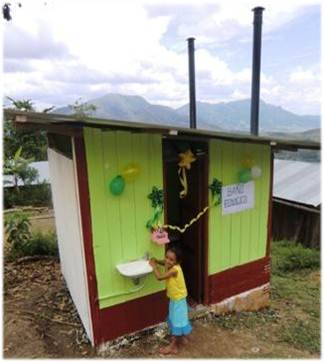 superstruc...holz.jpg
(Filesize: 18KB)
superstruc...holz.jpg
(Filesize: 18KB)
-
 base.jpg
(Filesize: 21KB)
base.jpg
(Filesize: 21KB)
-
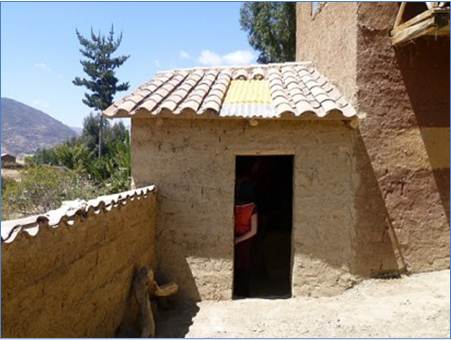 adobelisto2.jpg
(Filesize: 26KB)
adobelisto2.jpg
(Filesize: 26KB)
-
 basisbambus.jpg
(Filesize: 22KB)
basisbambus.jpg
(Filesize: 22KB)
-
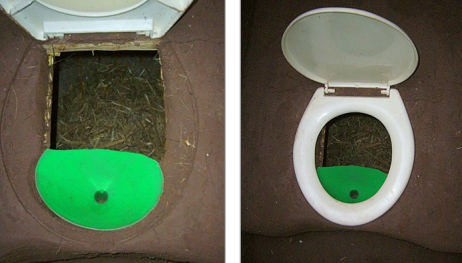 funil.png
(Filesize: 207KB)
funil.png
(Filesize: 207KB)
-
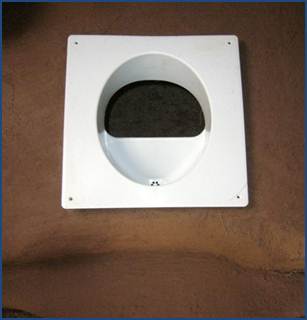 einsatz.jpg
(Filesize: 10KB)
einsatz.jpg
(Filesize: 10KB)
-
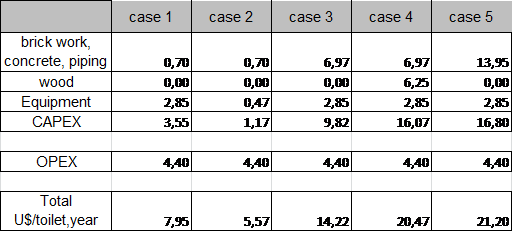 livecycle1.png
(Filesize: 12KB)
livecycle1.png
(Filesize: 12KB)
-
 peruse.png
(Filesize: 5KB)
peruse.png
(Filesize: 5KB)
-
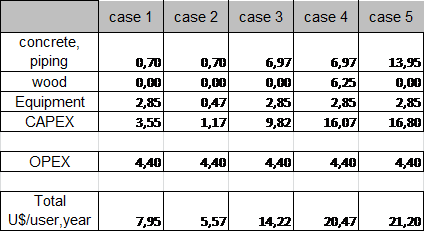 peruser.png
(Filesize: 10KB)
peruser.png
(Filesize: 10KB)
Please Log in to join the conversation.
You need to login to reply
Dear Christoph,
what labor costs are u thinking of? If people are cleaning their own toilets, I don't think that is considered a cost.
I would agree that a ball park figure for operation and maintenance of 10% of the capital investment per year is way too high with regards to private ecosan toilets. That figure of 10% per year would actually mean that maintenance costs would be a high as capital costs over a 10 year life span - in my view a completely ridiculous assumption.
H-A
what labor costs are u thinking of? If people are cleaning their own toilets, I don't think that is considered a cost.
I would agree that a ball park figure for operation and maintenance of 10% of the capital investment per year is way too high with regards to private ecosan toilets. That figure of 10% per year would actually mean that maintenance costs would be a high as capital costs over a 10 year life span - in my view a completely ridiculous assumption.
H-A
Hanns-Andre Pitot
M.Eng. Environmental Pollution Control
presently in Seesen, Germany
M.Eng. Environmental Pollution Control
presently in Seesen, Germany
Please Log in to join the conversation.
You need to login to reply
Dear Hanns-Andre,
it would be interesting to know some details of your calc.
Operational costs / year in special. The picture you posted makes me wonder how this can be done with U$ 180. Must be a special situation without labor?
Thanks for the information.
Yours
Christoph
it would be interesting to know some details of your calc.
Operational costs / year in special. The picture you posted makes me wonder how this can be done with U$ 180. Must be a special situation without labor?
Thanks for the information.
Yours
Christoph
Please Log in to join the conversation.
You need to login to replyOperating costs of dry sanitation (UDDTs) - and is 5% of household income a reasonable target?
Note by moderator (EvM): this discussion began in a different thread (forum.susana.org/forum/categories/139-ge...mit=12&start=24#5553) but has been moved to here so that it doesn't get lost in the other thread.
Dear Elisabeth, dear all,
Thank you for reminding about that post that I published last year! Of course, five cents per user per day are way too high. From my experience in Adjumani, I would say even 2 cents are very much on the high side as explained in that post. At one cent per user per day, I can see low income people who are staying in a town start thinking about the possibility of acquiring a toilet. These people generally like the idea of a toilet - perceived costs are the problem.
It's true, the Gates Foundation has kicked off a process of rethinking the toilet with their RTTC, and that's very positive. But at 5 cents per user per day, they'll end up building something for the well-to-do. Maybe, they are speculating on economies of scale in the long run in order to reduce costs, or they are willing to massively subsidise the toilets they intend to construct for the poor (which is a very big risk in itself). Otherwise they ought to rethink costs.
In the case of the low cost toilets of Adjumani, I've given some clues about how I've reached our figure (less than 2 cents per user per day - assume a 10 year life span, 5% interest on capital, and five users). If users can do without buying toilet paper (what low income people usually do), then operational costs should be negligible at least in the setting of Adjumani - that is until a major component needs replacement, like a plastic part (the reed mat door of our second low cost toilet will, of course, need replacement at some time). I would hope that this doesn't happen within the assumed life span of 10 years.
In Adjumani, in most of the town areas, the local composting facility is picking up both the solids and the liquids from ecosan toilets free of charge if requested to do so. It is using the solids in compost making and selling the liquids as fertiliser. So, there are almost no charges, too, in terms of collection and disposal/utilization.
Concerning capital costs, we found that the types of construction materials are the decisive factor. So, iron and cement are discouraged and clay or loam, preferably unburnt, is encouraged in order to minimise costs.
So, 2 cents are already achievable - and I am sure there are many more examples. Why is the BMGF not trying to beat that figure?
Regards to everybody,
Hanns-Andre
Dear Elisabeth, dear all,
Thank you for reminding about that post that I published last year! Of course, five cents per user per day are way too high. From my experience in Adjumani, I would say even 2 cents are very much on the high side as explained in that post. At one cent per user per day, I can see low income people who are staying in a town start thinking about the possibility of acquiring a toilet. These people generally like the idea of a toilet - perceived costs are the problem.
It's true, the Gates Foundation has kicked off a process of rethinking the toilet with their RTTC, and that's very positive. But at 5 cents per user per day, they'll end up building something for the well-to-do. Maybe, they are speculating on economies of scale in the long run in order to reduce costs, or they are willing to massively subsidise the toilets they intend to construct for the poor (which is a very big risk in itself). Otherwise they ought to rethink costs.
In the case of the low cost toilets of Adjumani, I've given some clues about how I've reached our figure (less than 2 cents per user per day - assume a 10 year life span, 5% interest on capital, and five users). If users can do without buying toilet paper (what low income people usually do), then operational costs should be negligible at least in the setting of Adjumani - that is until a major component needs replacement, like a plastic part (the reed mat door of our second low cost toilet will, of course, need replacement at some time). I would hope that this doesn't happen within the assumed life span of 10 years.
In Adjumani, in most of the town areas, the local composting facility is picking up both the solids and the liquids from ecosan toilets free of charge if requested to do so. It is using the solids in compost making and selling the liquids as fertiliser. So, there are almost no charges, too, in terms of collection and disposal/utilization.
Concerning capital costs, we found that the types of construction materials are the decisive factor. So, iron and cement are discouraged and clay or loam, preferably unburnt, is encouraged in order to minimise costs.
So, 2 cents are already achievable - and I am sure there are many more examples. Why is the BMGF not trying to beat that figure?
Regards to everybody,
Hanns-Andre
Hanns-Andre Pitot
M.Eng. Environmental Pollution Control
presently in Seesen, Germany
M.Eng. Environmental Pollution Control
presently in Seesen, Germany
Please Log in to join the conversation.
You need to login to reply
Share this thread:
- Markets, finance and governance
- Financing (taxes, tariffs, transfers) and cost estimates
- Operating costs of dry sanitation (UDDTs) - and is 5% of household income a reasonable target?
Recently active users. Who else has been active?
Time to create page: 0.420 seconds








